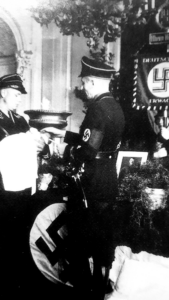by Adriana Allegri

When I first learned about Hochland Home, the setting for The Sunflower House, it seemed like the stuff of dystopian science fiction. Few people knew about this state-run baby factory, created to perpetuate Hitler’s so-called Master Race. In retrospect, that isn’t surprising—Heinrich Himmler ordered all records destroyed during the last days of WWII. The majority were, but enough remained to piece together the truth. And the more I researched, the more horrified I became.
For Heinrich Himmler, facilities like Hochland Home were a solution to a troubling problem. Germany’s birth rate had been in decline for years, and he needed to ensure the Thousand-Year Reich. Lebensborn (literally: ‘fount of life’) was Himmler’s answer—a ruthless eugenics effort to increase the number of healthy ‘racially pure’ Aryans.
Early accounts claim that Lebensborn facilities like Hochland Home began as residences for unwed mothers. They were places where girls could have their babies in peace and privacy before relinquishing the infants to ‘good’ families who would indoctrinate them in Nazi ideology.
While that simple description was enough to make me queasy, I soon learned something even more disturbing was happening. Despite Germany’s conservative cultural norms, many young women were more than willing—dedicated, in fact, to producing children for their Führer. There were accounts of young women bearing multiple children in rapid succession with different fathers. Keep in mind that each girl needed a doctor’s recommendation to be considered—and then submitted to a brutal intake process to prove her Aryan heritage. As many as half of the applicants were turned away.
This intense level of enthusiasm can be traced, at least in part, to indoctrination in the BDM (Bund Deutscher Mädel) or League of German Girls, the only legal female youth organization in Nazi Germany. Youth group leaders taught young girls that there was, quite simply, a shortage of men. While each girl couldn’t be guaranteed a husband, she could still become a mother for her Führer through ‘biological marriages’ with appropriate, racially pure partners. It was every woman’s sacred duty to bear as many children as possible for the good of the state. Sex became sport with a sacred purpose.
I’ve always seen Hochland Home, and other homes like it, as a study in contradiction and hypocrisy. Expecting mothers received the best food and medical care available. They took character-training classes that molded them into the German feminine ideal. Yet these women were nothing more than brood mares valued for their wombs. Their thoughts and feelings were of little consequence; only obedience was necessary.
The fate of many of the children born in these homes was heartbreaking. In public, infants were celebrated at Naming Ceremonies officiated by SS officers. In private, many children suffered from neglect. They were treated like inventory and didn’t bond with their birth mothers. Without enough nursing staff to tend them, as many as forty percent failed to thrive or were developmentally delayed.
Some families refused to pay for funeral expenses after the children they adopted died. Others complained when they never received their promised children. We also know that some children who failed to thrive were sent away to other facilities—and according to one doctor’s report, kept alive on morphine. This wasn’t done to mitigate the children’s pain, however; it was only so the doctor could assure Himmler he’d done everything possible to extend their lives.
Eventually, on Himmler’s direct authority, the program approved “the systematic elimination of all the abnormal children, who according to the principles of selective eugenic reproduction, should never have been born.”
As many as 25,000 children were born in Lebensborn facilities like Hochland Home in Germany and other countries across Europe. Many of the children who survived were unaware of their origins. But for those who were, and particularly those labeled ‘children of shame’ by classmates and neighbors, a disproportionate number suffered from mental health issues.
The Lebensborn program took everything that was sacred about motherhood and despoiled it. This should also come as no surprise. Nazi ideology is rotten to the core and damages everything and everyone it touches. But it’s the thought of all of those children—born innocent into this world—that haunts me.

Adriana Allegri is a first-generation American whose parents lived in Europe before, during, and after World War II. She grew up on stories about how small acts of compassion saved lives. A former high school teacher and educational program administrator, Allegri also served as a writer/project manager for a leading data analytics company. Allegri spent fifteen years in the New York metro area but is happily relocated in Chandler, Arizona with her two ornery rescue cats. The Sunflower House is her first novel.
